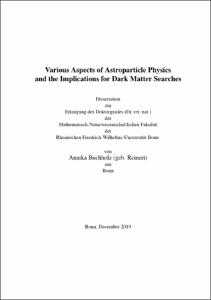Buchholz, Annika: Various Aspects of Astroparticle Physics and the Implications for Dark Matter Searches. - Bonn, 2020. - Dissertation, Rheinische Friedrich-Wilhelms-Universität Bonn.
Online-Ausgabe in bonndoc: https://nbn-resolving.org/urn:nbn:de:hbz:5-58246
Online-Ausgabe in bonndoc: https://nbn-resolving.org/urn:nbn:de:hbz:5-58246
@phdthesis{handle:20.500.11811/8345,
urn: https://nbn-resolving.org/urn:nbn:de:hbz:5-58246,
author = {{Annika Buchholz}},
title = {Various Aspects of Astroparticle Physics and the Implications for Dark Matter Searches},
school = {Rheinische Friedrich-Wilhelms-Universität Bonn},
year = 2020,
month = may,
note = {Cosmic rays offer an opportunity to search for dark matter, if the latter decays or annihilates into standard model particles. In the first part of this work, we address an excess that was claimed to be seen in the cosmic ray antiproton spectrum. Carefully evaluating the uncertainties of the analysis as well as their correlations, we show that the significance hardly exceeds 1σ. In the absence of an anomaly, we derive limits on the dark matter annihilation cross section that disfavor thermal WIMPs below roughly 500 GeV.
To go further, we question the general setup of typical homogeneous diffusion models.
We point out that the measured positron and electron+positron spectrum at TeV energies are consistent with the astrophysical background prediction, if energy losses are not relevant.
We propose alternative models of cosmic ray propagation that capture these properties, and discuss the consistency with various astrophysical measurements. It turns out that secondary electrons+positrons at TeV energy require short escape time ≤ 0.1 Myr. We show that this implies that the cosmic rays at these energies have seen an average density of interstellar matter of a few particles per cm3. This number is so far consistent with observations, but requires further investigation, e.g. through starlight extinction maps or γ-ray surveys.
In the last part we look at four explicit models of dark matter with a small coupling to the visible sector through the electromagnetic interaction, namely through a dark photon portal or through an electric or magnetic dipole moment. The small couplings prohibit thermalization with the standard model sector in the early universe, such that typical constraints for dark matter masses in the keV range are avoided. Instead, the dark matter may have been produced through annihilations and decay of standard model particles into the dark sector, so-called 'freeze-in' production. The parameters that reproduce the observed relic abundance can partially be constrained by stellar cooling arguments and upcoming direct detection experiments.},
url = {https://hdl.handle.net/20.500.11811/8345}
}
urn: https://nbn-resolving.org/urn:nbn:de:hbz:5-58246,
author = {{Annika Buchholz}},
title = {Various Aspects of Astroparticle Physics and the Implications for Dark Matter Searches},
school = {Rheinische Friedrich-Wilhelms-Universität Bonn},
year = 2020,
month = may,
note = {Cosmic rays offer an opportunity to search for dark matter, if the latter decays or annihilates into standard model particles. In the first part of this work, we address an excess that was claimed to be seen in the cosmic ray antiproton spectrum. Carefully evaluating the uncertainties of the analysis as well as their correlations, we show that the significance hardly exceeds 1σ. In the absence of an anomaly, we derive limits on the dark matter annihilation cross section that disfavor thermal WIMPs below roughly 500 GeV.
To go further, we question the general setup of typical homogeneous diffusion models.
We point out that the measured positron and electron+positron spectrum at TeV energies are consistent with the astrophysical background prediction, if energy losses are not relevant.
We propose alternative models of cosmic ray propagation that capture these properties, and discuss the consistency with various astrophysical measurements. It turns out that secondary electrons+positrons at TeV energy require short escape time ≤ 0.1 Myr. We show that this implies that the cosmic rays at these energies have seen an average density of interstellar matter of a few particles per cm3. This number is so far consistent with observations, but requires further investigation, e.g. through starlight extinction maps or γ-ray surveys.
In the last part we look at four explicit models of dark matter with a small coupling to the visible sector through the electromagnetic interaction, namely through a dark photon portal or through an electric or magnetic dipole moment. The small couplings prohibit thermalization with the standard model sector in the early universe, such that typical constraints for dark matter masses in the keV range are avoided. Instead, the dark matter may have been produced through annihilations and decay of standard model particles into the dark sector, so-called 'freeze-in' production. The parameters that reproduce the observed relic abundance can partially be constrained by stellar cooling arguments and upcoming direct detection experiments.},
url = {https://hdl.handle.net/20.500.11811/8345}
}






